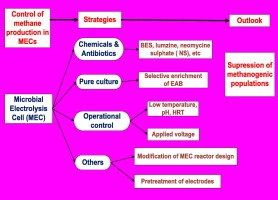Bioelectrochemistry ( IF 4.8 ) Pub Date : 2017-10-14 , DOI: 10.1016/j.bioelechem.2017.09.014 Abudukeremu Kadier , Mohd Sahaid Kalil , Kuppam Chandrasekhar , Gunda Mohanakrishna , Ganesh Dattatraya Saratale , Rijuta Ganesh Saratale , Gopalakrishnan Kumar , Arivalagan Pugazhendhi , Periyasamy Sivagurunathan

|
Microbial electrolysis cells (MECs) are perceived as a potential and promising innovative biotechnological tool that can convert carbon-rich waste biomass or wastewater into hydrogen (H2) or other value-added chemicals. Undesired methane (CH4) producing H2 sinks, including methanogens, is a serious challenge faced by MECs to achieve high-rate H2 production. Methanogens can consume H2 to produce CH4 in MECs, which has led to a drop of H2 production efficiency, H2 production rate (HPR) and also a low percentage of H2 in the produced biogas. Organized inference related to the interactions of microbes and potential processes has assisted in understanding approaches and concepts for inhibiting the growth of methanogens and profitable scale up design. Thus, here in we review the current developments and also the improvements constituted for the reduction of microbial H2 losses to methanogens. Firstly, the greatest challenge in achieving practical applications of MECs; undesirable microorganisms (methanogens) growth and various studied techniques for eliminating and reducing methanogens activities in MECs were discussed. Additionally, this extensive review also considers prospects for stimulating future research that could help to achieve more information and would provide the focus and path towards MECs as well as their possibilities for simultaneously generating H2 and waste remediation.
中文翻译:

超越目前在微生物电解池(MEC)中产生高纯度H 2的限制:抑制产甲烷菌生长的策略
微生物电解池(MEC)被认为是一种潜在且有前途的创新生物技术工具,可以将富含碳的废物生物质或废水转化为氢(H 2)或其他增值化学品。产生甲烷(CH 4)的不希望有的H 2汇,包括产甲烷菌,是实现高H 2产量的MEC面临的严峻挑战。产甲烷菌可以消耗H 2在MEC中产生CH 4,这导致H 2的生产效率,H 2生产率(HPR)下降以及H 2的百分比降低。在产生的沼气中。与微生物和潜在过程的相互作用有关的有组织推论有助于理解抑制产甲烷菌生长的方法和概念,并有利于规模化设计。因此,在这里,我们回顾了当前的发展以及为减少微生物H 2而进行的改进产甲烷菌的损失。首先,实现MEC的实际应用面临的最大挑战;讨论了不良微生物(甲烷原)的生长以及消除和减少MEC中产甲烷菌活性的各种研究技术。此外,本篇广泛的综述还考虑了刺激未来研究的前景,这些前景可能有助于获得更多信息,并提供了转向MEC的重点和途径,以及它们同时产生H 2和废物修复的可能性。









































 京公网安备 11010802027423号
京公网安备 11010802027423号